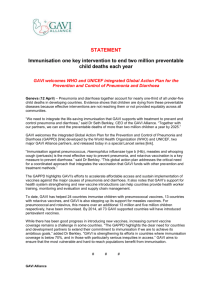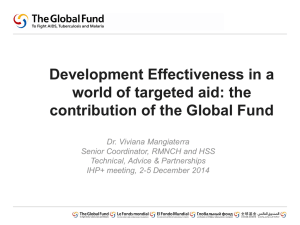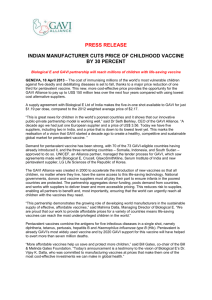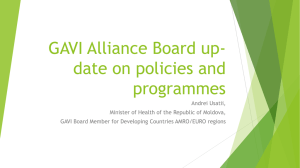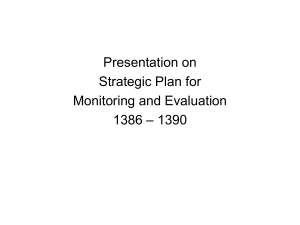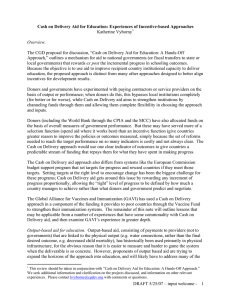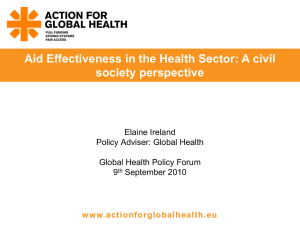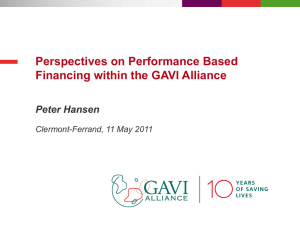Delay in implementation - Country Planning Cycle Database
advertisement
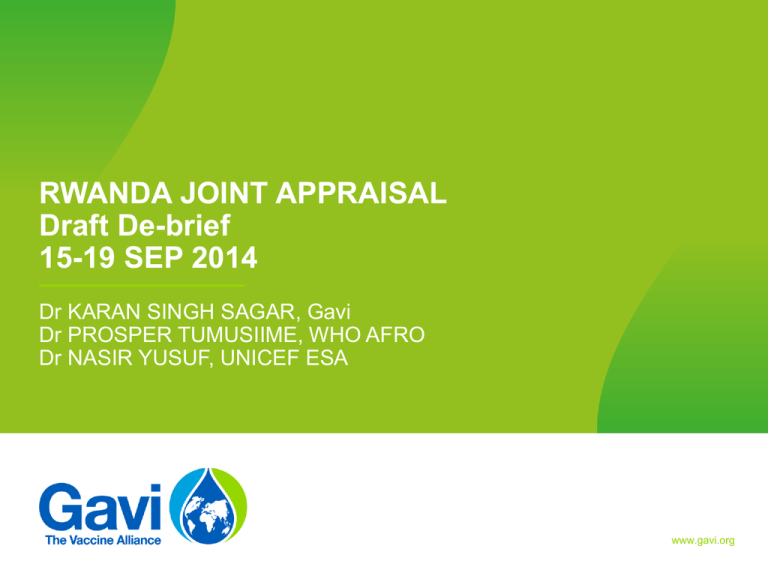
RWANDA JOINT APPRAISAL Draft De-brief 15-19 SEP 2014 Dr KARAN SINGH SAGAR, Gavi Dr PROSPER TUMUSIIME, WHO AFRO Dr NASIR YUSUF, UNICEF ESA www.gavi.org ACKNOWLEDGEMENT • • • • • • • • • Hon Minister and State Minister of Health Hon Minister of Economic Planning VPDP SPIU Staff of the District Hospitals and Health Facilities Alliance partners: WHO & UNICEF CO USAID RBC ICC members and all others 2 GAVI SUPPORT TO RWANDA (since 2000) 140,000,000 132,364,784 120,000,000 107,030,771 106,873,782 100,000,000 91,132,617 80,000,000 60,000,000 40,000,000 15,741,163 20,000,000 0 Total Commitment 3 Approvals Disbursements Amount in US$ Vaccine Support Non vaccine support AIM of Joint Appraisal • The aim of the Joint Appraisal is to assess the performance of GAVI support, identify challenges and opportunities, review future targets and suggest actions. • Health System Strengthening (HSS) and all forms of New Vaccine Support (NVS). 4 Process • Preparatory work • Gavi secretariat and in-country • Review of documents • Appraisal Mission from 15-19 Sep 14 • Meeting with MoH/ICC • Meeting with Stakeholders (Partners: WHO, UNICEF, USAID) • Meeting with CSO, SPIU, VPDP • Field visit: 3 DH and 3 HF • Meeting with MINECOFIN • De-brief 5 Achievements and Constraints • Rwanda has achieved immunization coverage above 95% for all antigens, and 94% FIC (Survey). • Factors have contributed to the achievement • • • • High political commitment Improvement of health system delivery Involvement of Community Health Workers (CHWs) Highly motivated and dedicated staff • VPD have been controlled in Rwanda. • Tremendous progress in the reduction of child mortality since 2000 (151 in 1990 to 55 in 2013) 6 PCV3 coverage analysis Focus for routine coverage improvement Rota last dose coverage analysis ** * * * 2013 intros • Rota last dose coverage lags behind DTP3 in the first full year of intro, with age restrictions likely contributing to low coverage; Ghana and Rwanda being an exception shows encouraging signs * Partial year intros ** Data reporting issue in Armenia leading to artificially low coverage Challenges • • • • 9 Sustaining the high coverage New Vaccine introduction Use of data for action Financial Sustainability Coordination and Governance • Rwanda has a well functioning ICC & HSCC • Broad representation: MoH, WHO, UNICEF, USAID, RBC, CSO and others • Advisory body to MoH and approves all technical decisions (like NVI, HSS implementation) • No National Immunisation Technical Advisory Group (NITAG)- should be explored • Maintain the momentum of committee meetings and the representation of all partners. 10 Programme Management • M & E framework in place for management of GAVI HSS and NVS • Indicators are aligned with cMYP and HSSP • Annual plans for EPI program exists at the national and district level. • At district and HF levels, these are mostly operational plans. • National and district plans are costed. • Funding for traditional vaccines and vaccination material from government, while it has increased its co-financing to 0.35USD. 11 PM…2 • Target population for the various antigens was previously based on projections from previous census, • After census in 2012 the proportion of children less than 1 year has since been adjusted from 4.1 – 2.9%. • This adjustment is leading to more than 100% coverage at health centre level by end of year. 12 Planning • At district hospital level, there are two sets of plans: • An integrated costed work plan for the entire districts that has all the programs • An EPI specific work-plan with details and costs for 4 – 6 months. • Plans are based on previous performance and targets the weak components of the program • National level supports district level to conduct planning every 6months. 13 Planning • At health centre level: • There is a weekly immunization service delivery schedule • Integrated Outreach activities conducted once a month • RED activities included in DH plan, but no indication of REC micro plan at the health centre level • Need to improve quality of RED/REC implementation with focus on Health centre micro planning with focus on poor performing health centres. 14 Supervision • Supportive supervision sessions are conducted from central to district level and from district level to health centre level. • Quarterly SS visits from national level • There are both integrated and EPI supervisory checklists at the district hospital level. • District hospital conducts quarterly supportive supervision to health centres targeting poor performing districts. • Reports, feedback and follow up plans available 15 Supervision • There is also a monthly supervision visits to health centres to monitor the PBF. • In both cases, written feedback is provided, and monitored subsequently to ensure that recommendations are implemented. • Need for periodic EPI specific M&E and supervision visits • Train EPI focal persons in data analysis and use 16 Coordination meeting • District hospital holds monthly meeting with health centres to review status of implementation of work plan, and address gaps. • Monitor only BCG and MCV as access and utilization indicators • Many HF performing over 100% or some under 80% • Need to have quarterly EPI specific review at DH level 17 M&E Issues • Monitoring of RI data is through computerized HMIS • Data managers and M & E officers analyze program performance and share with HF. • Quality of data is discussed during monthly meetings and measures to improve quality outlined. • Rota PIE indicated that the use of data for program planning is rare at the district hospital and health centre levels. • A number of program reviews in the country identified data quality as concerns especially at the district hospital and health centre levels. 18 Other assessments • DH & HF staff given DQS training in the past years Program reviews conducted • • The integrated measles post SIAs coverage survey in 2013, showing more than 90% coverage for most of the antigens All seven key recommendations from the 2011 EVMA were implemented. A follow up EVMA was conducted in June 2014 and an improvement plan has been developed for implementation. Rota vaccine PIE conducted in 2013 Rota vaccine and PCV impact studies • • • . 19 VPD Surveillance • Integrated VPD surveillance system in place • Gavi/WHO supporting the system • Core AFP and measles case-based surveillance indicators achieved at national and sub-national levels. • WHO uses RI and AFP surveillance indicators to identify high-risk districts for polio using standard risk assessment tools • Need to assess silent areas and improve reporting 20 Programme Delivery • GAVI support to NVS and HSS gives opportunities to enhance RI • RED implementation is good at DH levels and health centres, • Components of RED implemented but not well structured. • DH & HF visited are well organized, plans & report exist • Role of CHW is very important in IPC and defaulter tracing 21 Program Delivery • Delays in HSS funds transfer-Gavi • Delays in implementation of HSS planned activities • Long processes in Govt procurement systems • There is over-stoking of some antigens at central level especial of RV, the shipment plan is being revised and pushed for many antigens for the planned shipment 2014. 22 Recommendation • • • • • Review HSS funds implementation plan and make a catch-up plan and request that transfer of funds is timely done Procurement of cold chain equipment may be done through UNICEF to reduce lead time & assure quality & standards equipment. Review immunization forecast and shipment plans at regular basis to avoid over or under-stoking of vaccines at all levels Monitor the implementation of RED at all levels especially micro-plans development and implementation Documentation on the lessons learned 23 Global Polio Eradication Initiative • Last case in 1993 from Nyamasheke District • Surveillance supported through Gavi/WHO • Surveillance indicators are being met • Some silent areas not reporting AFP cases • IPV introduction planned in Aug 2015 • Concern: 3 injections at same time • Cold chain capacity at national and district • Supervision needs to be strengthened 24 Health System Strengthening • Of the 31 planned activities, 3 (9.7%) have been completed, 16 (51.6 %) are on-going while 12 (38.7 %) have not yet been implemented. • Out of the first year budget of USD 2,462,813, USD 1,642,814 (66%) has been disbursed by the SPIU, while, in total, USD 1,491,017 (60%) has been spent or committed. • All expenditure was for planned activities 25 HSS • Delay in implementation: Gavi transfer • Challenges related to turnaround time for procurements (goods and services) associated with the tendering processes • Initial delays in transferring funds from VPDD/RBC to District Hospitals caused by lack of an MOU between them (this has now been resolved). • Sequential and depend on completion of others that are yet to be completed. 26 HSS • Some of the activities have been rescheduled to be completed in first quarter of 2015. 27 HSS • Out of the 7 outcome indicators for year one, 4 were achieved, 1 was not achieved while 2 others could not be measured as they are obtained from a DHS; • Out of 8 intermediate result indicators, 5 were achieved while 2 were not achieved and the other was not measured as there was no DQRC done; • 4 intermediate result indicators did not have baselines and consequently the level of achievement could not be assessed for the two that had a measure for the year 28 HSS • The M&E for HSS is satisfactory. • Missing baselines should be established at least for subsequent years and the periodicity of measuring the indicators synchronised with the timing of the sources of relevant data. • The program and financial reporting needs to be further improved by specifying the status of the activities and to clearly spell out how much has been spent and how much has been committed. • MOH will update the status as agreed during the appraisal. 29 TA • During year one, only one activity for TA was planned for development of the communication strategy for the health sector for which money has been requested; • The immunization program, received quality technical support from WHO and UNICEF for training mid-level health managers in M&E and for conducting EVM and cold chain spare parts inventory; • Technical assistance has been planned in year 2 for: • • • • • External evaluation of immunization program; Operational research (HMIS/EPI Data Quality Assessment and EVM) for monitoring and evaluation of EPI performance; Creation of elimination model for measles/rubella surveillance; Service availability and readiness assessment. 30 CSO engagement • CSO have been supporting MoH for various EPI and SIA related activities (SM, BCC) • For current HSS process for selection and engagement of the CSOs is not yet finalized • The publication of expression of interest is for the week of the appraisal. • This should be expedited 31 Next Year Plan • The proposed GAVI-funded HSS activities are in accordance with the approved grant activities. • There is no change in objectives and no shifts in the budgets. The only change is with regard to the activity on allowances to five RBM provincial mentors, where the budget line will be reallocated to PBF. • MOH will need to officially notify GAVI Secretariat on this change. 32 HSS • The GoR wishes to align the GAVI HSS funding to the government planning cycle (June/July) • GAVI Secretariat agreed to explore the feasibility of the request to use year 2 tranche and balance from year 1 for the period up to June 2015 and thereafter carry over the remaining balance, if any, into year 3. 33 Use of non-HSS Cash Grants from GAVI • Rwanda planned and implemented an integrated Measles and Rubella vaccination campaign (for under 15), • The campaign targeted 4,278,528 under 15 and reached 97.5% (as per the PCE). • WHO received USD 3,064,954 for the campaign and as per the financial statement received from WHO 99.6 % of funds were utilized. 34 MR Campaign • The PIE noted that VPDD staff should undertake supervisory visits to DH & HF to provide on job training/support to field staff on better delivery of immunization service as well as conduct a real time monitoring of the EPI program. • Introduction of MR in the routine program in Jan 2014. • The country received US$ 299,500 as VIG in Nov 2013. Not able to use the funds in the reporting period (till Dec 2013) • To submit a workplan for utilization of these funds. 35 Financial Management • The Ministry of Health is the lead implementer of Gavi support in the country. • The funds are handled by SPIU (Single Project Implementation Unit) • For HSS funds, the sub-recipients VPDP and MCH • The funds disbursement is approved after the relevant program submits a workplan (usually on quarterly basis, which has been approved by the ICC) along with financial statements of previous quarter. 36 FM • The system appears to be functioning well; • Some delays at the start up (signing of MoU between PR and SR, between SPIU and districts and opening of Gavi fund bank accounts). • Fund flow to DH & HF is timely and there are no issues of delayed financial reporting. 37 FM • The next tranche of US$ 1,977,144 has been approved and will be released after the country submits the reports and financial statements for the current tranche. • The country is eligible for a PBF payment • Need to keep asset register for all procurements made through Gavi funds. • Promote culture of keeping assets in good-condition 38 RBC • The country has decided to use the Rwanda biomedical centre as the implementing arm, • To submit a note & relevant documents informing Gavi about this change by Oct 2014. • The PFA and annex 6 may need to be revised based on the new organizational structure and fund management procedures that will be adopted by RBC. 39 NVS Targets • The coverage for all antigens is over 90% and there aren’t major issues related to the coverage, equity and quality of service delivery. • The country was calculating its targets as 4.1% of the total population but has now revised the estimates to 2.9%. • This drop of 30% in number of surviving infants will have an impact on the vaccine doses required, co-financing payments etc. 40 NVS targets • During the field visit it was observed that when the target was based on 4.1%, the coverage was almost 100% and after calculating target population based on 2.9%, the health facilities and district coverage’s are over 100%. • This needs to be investigated in detail by the country to get a real estimate of the target or else it can impact the performance of the program (affecting the vaccine supply, coverage etc.). 41 Immunisation Financing and Sustainability • Rwanda is a low income country with a GNI of US$ 620. • Vision is to become middle income country by 2020 (GNI of US$ 1240)- co-financing • In 2013 the total spending on immunization was reported to be US$ 25.55 million, out of which the government spent US$ 3.88 million (15.2%), Gavi funded US$ 19.07 (74.63%) and rest US$ 2.59 million (10.1%) was provided by WHO, UNICEF and MERCK. 42 Immunisation Financing and Sustainability • The overall health sector budget has increased from Rwf 66.28 billion in 2010/11 to Rwf 79.45 billion (20% increase). The increase in immunization budget over the same period has been from Rwf 1.65 billion to XXX billion. • EPI program has a separate line item budget in the national budget and the country funds the purchase of the traditional vaccines and part of operational costs. • The country has not defaulted on its’ co-financing payments since 2009. There is a need to increase the government funding, especially for operational costs (currently under Gavi HSS). 43 Technical Assistance • • • The country offices of WHO and UNICEF provide coordinated assistance to the MoH/EPI on proposal development, guidelines, trainings, conducting special studies (like HPV and Rota surveillance). Rwanda is requesting for technical assistance for developing financial sustainability strategies for both running day to day immunization related activities, cofinancing vaccines and updating costing tool for cMYP. The country also needs assistance with documentation of the success stories in the health sector program. 44 Thank You www.gavi.org
